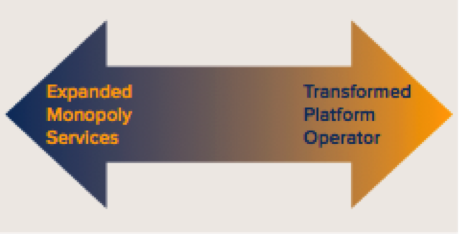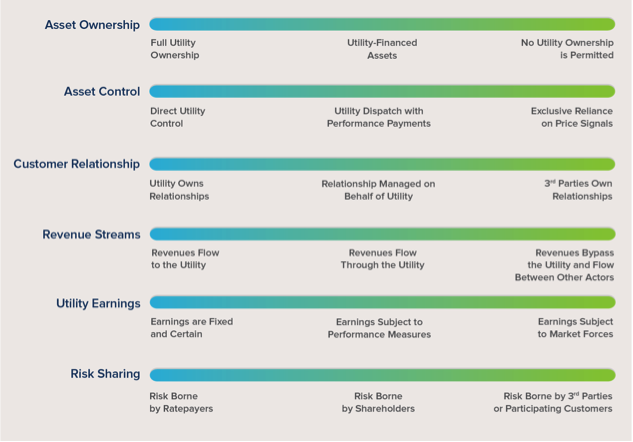
Report Release: Reimagining the Utility to Bring “Utility of the Future” Debates Down to Earth
A lot of attention is given to the question: what is the right role and business model for electric utilities? This has become something like the energy industry’s version of what is the meaning of life, existential in nature and prone to as many answers as there are names on the waitlist for the Tesla Model 3. Utilities, businesses, environmentalists, and others stake out positions on some weighty questions: Should utilities be allowed to own distributed resources? Do natural monopoly conditions, on which utility regulations have been premised, persist in the modern era? How can we effectively evolve the incentives for rate-based capital investment embedded in historical cost-of-service ratemaking approaches?
Unfortunately, these questions tend to get mired in the abstract and hypothetical, clouded by attempts to make universal pronouncements for the future grid meant to apply in all cases. Lost from the conversation are the practical implications of specific decisions, as well as a coherent line of sight to the end goals we seek from our electricity system. RMI’s latest report, Reimagining the Utility, brings these questions down to earth. It provides an analytic lens for evaluating utility reforms, as well as new programs and investments large and small, to understand how they may support or hinder progress toward bigger objectives for modernizing and decarbonizing the grid. This approach is informed by RMI’s close work with utility regulators and utilities on some of the leading reform efforts in the country, and should help decision makers in PUCs, utility board rooms, and stakeholder conversations better structure their problem solving on these issues. A version of the report was previously submitted to Smart Electric Power Alliance’s (SEPA’s) 51st State Initiative.
Fundamental Questions Confronting the Utility Business
The electric utility must modernize to serve new economic and policy objectives, including managing an increasingly distributed and decarbonized power system. A fundamental question for this future system is:
What is the appropriate scope for utility functions versus those that should be provided from a competitive marketplace, and by extension, what is the appropriate size of the utility business enterprise and its associated earnings?
As new roles and services emerge in the electricity sector, the total energy services market has the potential to grow, regardless of who performs those roles (be it a competitive marketplace or monopoly utilities). This can provide new activities around which to orient the future utility business, and create new earning opportunities as traditional revenues might decline or be subject to competition.
These questions, coupled with growing demand for decentralized energy services, point to an evolving electricity market as well as new earnings opportunities for both utilities and new entrants. This is not a new phenomenon. Today’s concerns are part of a decades-long evolution of the utility business, which has not been precisely the same in all jurisdictions but is generally marked by a shift toward more competition in generation and transmission of energy, and market entry by new actors. In the current chapter of this evolution, in which distributed energy resources are flourishing and capabilities from modern digital communications allow new modes of customer and third-party interaction, boundaries for utility roles and functions are again being redrawn. That includes some of the following possibilities being tested or on the horizon:
- Complete retail choice by customers, not only for supply of electricity but also broader energy services and customers’ role in grid stability
- New roles for “distribution system operations” or market hosting, as DERs are connected and the traditional power flow in only one direction is upended
- Potential for new utility services, such as EV charging infrastructure or microgrid management
- Possible utility function as an intermediary of third-party services based on its status as a trusted advisor
Weighing these and related possibilities requires a rethinking of the underlying economic assumptions and models that have underpinned the utility sector for decades.
Options for the Future Utility
To frame the discussion of the role of the distribution utility, the report describes two relative extremes on the utility of the future spectrum (which have been proposed in similar forms elsewhere; see Peter Fox-Penner’s Smart Power for one example): Expanded monopoly services and transformed platform operator.
In the expanded monopoly services model, a regulated utility would leverage economies of scale and scope, including a low cost of capital, existing customer relationships, and familiarity with system needs, to deliver DER services to customers. This model places the vast majority of DER service functions in the hands of the utility, including everything from ownership and management of the distribution system, to installation and operation of customer-sited assets such as rooftop PV, storage, and demand-response programs.
In contrast, the transformed platform operator would provide a neutral platform to integrate and coordinate energy services at the distribution level. Support for this approach is premised on a view that natural monopoly and economy-of-scale conditions may no longer exist (or can be eliminated through appropriate reforms), and third parties or end users can perform sales, ownership, and management functions as well or better than utilities. In this model, utilities could create new value as facilitators of a multiparty system, either as a regulated investor-owned entity or in a new nonprofit or government-chartered structure similar to today’s independent system operators.
While both models have merit, they also have some notable limitations. The expanded utility with a broadly granted monopoly risks crowding out innovation, and utilities may be unwilling to take on new roles for financing customer-sited investments. Conversely, limiting utilities strictly to playing the role of a platform host for third-party services could result in new service innovation that predominantly benefits more affluent customers, while low- and moderate-income populations are relatively ignored by the competitive market.
In practice, most attempts to evolve the utility business are likely to be some hybrid of these approaches. The report identifies four hybrid models and discusses examples where these are being tried:
- Utility procurement of third-party solutions
- Split roles by product or scope of activity
- Utility competition with third parties
- Utility hosted microplatforms
Regulation remains essential in any future
Regardless of the model chosen for each jurisdiction, regulation remains essential given the centrality of electricity in the modern economy, the environmental externalities it creates, and critical access and affordability concerns.
Importantly, regulators (in consultation with utilities and stakeholders) have a key role in setting a vision for the electricity system they seek. This is essential to provide a common reference point and criteria to guide subsequent reforms. Then, after a guiding vision is established, countless individual decisions and compromises will ultimately determine the course for utility modernization, as utilities and the market develop new products and revenue sources to build operational and business experience for the future system.
At every turn, utility program designers and regulators should evaluate proposals against key variables around utility role, revenue, and risks. The figure below provides a set of “sliders” that are helpful to evaluate how specific changes will support or inhibit progress toward the articulated vision. There is no “right” place to be on each variable, and in some cases a particular program or investment might occupy more than one location on a given range depending on one’s perspective or aspect of the program (e.g., customer payments to a service provider versus subscription fees paid to a platform provider). Thinking through where a program lands on each variable helps to illuminate possible implications of the activity and whether outcomes will be as intended, or in some cases identify possible unintended outcomes.
Of course, regulators will need to continually monitor the market to support the business model transition they seek. In the case of expanded monopoly, regulators need to be attuned to risks from imprudent investments, burdens to nonparticipants, and reduced business efficiency and innovation from reduced competition—all while avoiding potential information asymmetries that challenge monitoring new services and ensuring system benefits. In the case of a transformed platform provider, regulators should focus on developing standards for fair market access, oversight of new revenue streams, and consumer protections for new services.
Whatever the model pursued, thoughtful decision analysis is needed to understand and refine any business and regulatory decisions. Based on countless conversations with utility managers and regulators, and participation in some of the leading utility reform efforts in the U.S., we have seen a chasm between broad visions for the future system and the specific, often minute decisions of individual investments and program design. We hope that this report makes a contribution to the necessary reforms of utilities’ business models. As major changes and disruption occur in the power sector, decision frameworks and clear-eyed assessments of available options offer the opportunity to achieve win-win solutions for utilities, third parties, customers, and the environment.
Download Reimagining the Utility here.

